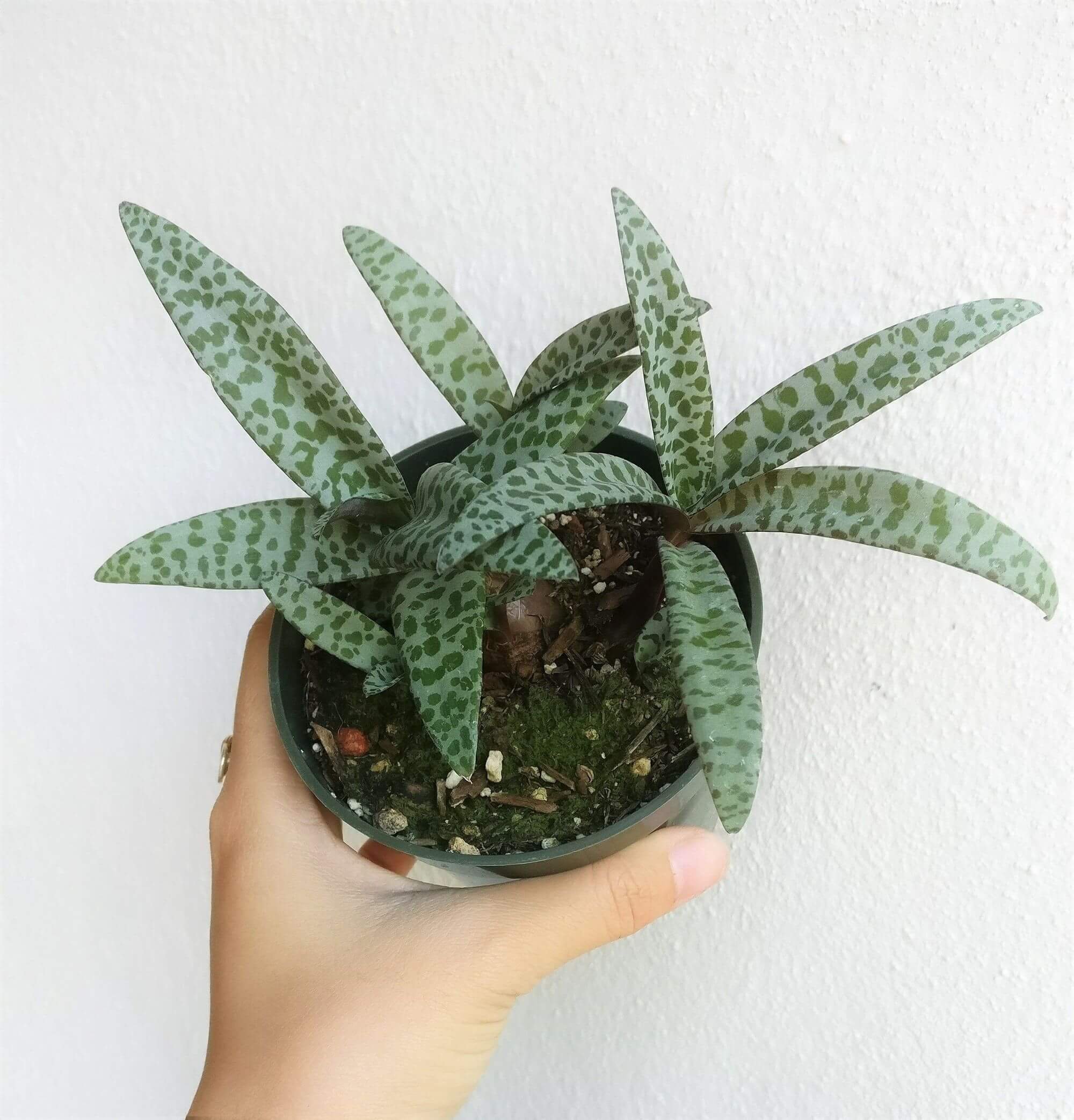How to Grow and Care for Silver Squill Plants
Discover how to grow and care for Silver Squill plants with our easy-to-follow guide. Learn the best tips for sunlight, watering, and soil to keep your Silver Squill thriving indoors or outdoors.
Image from: Succulents Box
Looking for a unique, low-maintenance plant that will bring a little sparkle to your home or garden? Enter the Silver Squill (Ledebouria socialis)! With its silvery leaves speckled with green and its bulb-like growths, the Silver Squill is as striking as it is easy to care for. Whether you're a seasoned plant parent or just dipping your toes into the world of indoor gardening, this tough little beauty can be the star of your plant collection. In this guide, we’ll walk you through How to Grow and Care for Silver Squill Plants, offering simple tips that’ll keep your plant happy and thriving. Let’s get started!
How to Grow and Care for Silver Squill Plants: The Basics
Before we dive into care tips, let’s talk a little about what makes the Silver Squill so special.
Native to South Africa, Silver Squill plants thrive in dry, rocky regions, which means they’re quite drought-tolerant and prefer a bit of neglect over too much fussing.
Bulbous Growth: The plant grows from small, above-ground bulbs that produce long, pointed leaves speckled with silver. In the right conditions, it’ll even bloom with delicate white or pink flowers.
Semi-Succulent Nature: While not a true succulent, the Silver Squill’s fleshy leaves store water, meaning it doesn’t need frequent watering.
Light Requirements: Bright, But Not Direct
When it comes to sunlight, Silver Squill plants love bright, indirect light.
Indoor Care
Bright, Indirect Light: Place your Silver Squill near a sunny window where it gets plenty of light without direct sun exposure, which can scorch those gorgeous leaves.
South-Facing Windows: A south or east-facing window is usually ideal, but if the light seems too intense, consider moving it back a bit or using sheer curtains to diffuse the light.
Outdoor Care
Partial Shade: If you're growing Silver Squill outdoors, place it in an area with partial shade. Too much direct sun, especially in hot climates, can damage the leaves.
Warm Climates: In regions with mild winters, Silver Squill can thrive outdoors year-round. Just be sure to bring it inside if temperatures dip below 40°F (4°C).
How to Grow and Care for Silver Squill Plants: Watering
Now that we've got the light situation handled, let’s talk about watering. Since Silver Squill plants are semi-succulents, they’re not big fans of overwatering.
Watering Schedule
Water Sparingly: Water your Silver Squill only when the top 1-2 inches of soil are completely dry. During the growing season (spring and summer), this may be every 1-2 weeks, but in the cooler months, you can cut back even more.
Drainage is Key: Make sure your pot has drainage holes, and avoid letting the plant sit in water. Wet feet can lead to root rot, and no one wants that!
Caring for a Silver Squill requires attention to its specific water needs and ensuring proper drainage. This unique plant thrives when watered sparingly, so it's important to wait until the top 1-2 inches of soil are completely dry before giving it a drink. During its active growing season in spring and summer, this may mean watering every 1-2 weeks. However, as the weather cools in fall and winter, you can reduce watering even further. Just as crucial as proper watering is good drainage. Always use a pot with drainage holes to prevent water from collecting at the roots, which can cause root rot. With the right balance of water and drainage, your Silver Squill will stay healthy and flourish.
Overwatering Warning Signs
Yellow Leaves: If you notice the leaves turning yellow or mushy, it’s likely a sign of overwatering. Let the soil dry out before watering again.
Bulbs Rotting: Soft, soggy bulbs can also be an indication that the plant is getting too much water. If this happens, trim the damaged bulbs and adjust your watering schedule.
Overwatering is one of the most common issues when caring for a Silver Squill, and it often shows up in the form of yellow or mushy leaves. If you notice this happening, it's a clear sign that your plant is receiving too much water. To remedy this, allow the soil to dry out completely before watering again, and adjust your watering schedule moving forward. Another indicator of overwatering is rotting bulbs. Soft, soggy bulbs suggest that the plant has been sitting in water for too long. If this occurs, trim away the damaged bulbs and make sure to water less frequently. Proper care and attention to your plant’s moisture needs will help keep it thriving and healthy.
Soil and Repotting: Give It the Right Foundation
The key to happy Silver Squill plants is well-draining soil. These plants like their roots to dry out between waterings, so choosing the right mix is essential.
Soil Mix
Cactus or Succulent Mix: A well-draining cactus or succulent soil mix is perfect for Silver Squill plants. You can also mix regular potting soil with perlite or sand to increase drainage.
Avoid Heavy Soils: Stay away from heavy, moisture-retentive soils that hold too much water. A quick-drying mix will keep your plant's roots healthy and happy.
Choosing the right soil is essential for keeping your Silver Squill healthy, and a well-draining mix is key. A cactus or succulent soil mix works perfectly, as it allows water to drain quickly and prevents the roots from sitting in excess moisture. If you don’t have succulent soil on hand, you can create your own by mixing regular potting soil with perlite or sand to enhance drainage. It’s important to avoid heavy, moisture-retentive soils, as they tend to hold too much water, which can lead to root rot and other problems. By using a light, quick-drying mix, you’ll ensure your Silver Squill’s roots stay dry and healthy, promoting vibrant growth and a happy plant.
Repotting Tips
Infrequent Repotting: Silver Squill plants don’t need frequent repotting. They actually prefer being a bit root-bound, so only repot every 2-3 years or when the bulbs seem overcrowded.
Springtime Repotting: If you do repot, do it in the spring, just before the growing season starts. Be gentle with the bulbs, and use fresh, well-draining soil.
Silver Squill plants are quite low-maintenance when it comes to repotting and actually thrive when they are a bit root-bound. This means you won’t need to repot them frequently—typically only every 2-3 years or when the bulbs become overcrowded. When it’s time to repot, the best season is spring, just before the plant enters its active growing phase. During repotting, be sure to handle the delicate bulbs carefully and plant them in fresh, well-draining soil to encourage healthy growth. Using a cactus or succulent mix, or a blend of potting soil with added perlite or sand, will ensure proper drainage. By repotting sparingly and at the right time, your Silver Squill will continue to thrive in its new environment.
How to Grow and Care for Silver Squill Plants: Fertilizing
Like most houseplants, Silver Squill appreciates a little extra nutrition, but you don’t want to overdo it.
Fertilizer Type
Balanced Fertilizer: Use a balanced, water-soluble fertilizer diluted to half strength during the growing season (spring and summer).
Once a Month: Feeding your plant once a month is usually plenty. During the fall and winter, when the plant enters its resting phase, you can skip the fertilizer altogether.
Feeding your Silver Squill the right nutrients will help it thrive, but it’s important to do so in moderation. During the growing season, which spans spring and summer, use a balanced, water-soluble fertilizer diluted to half strength to provide your plant with the necessary nutrients. Fertilizing once a month is usually sufficient to support healthy growth without overwhelming the plant. However, during the fall and winter months, when the plant enters its dormant phase, you can skip fertilizing altogether, allowing it to rest. By providing a balanced feeding schedule and reducing fertilizer in the off-season, your Silver Squill will stay healthy and vibrant throughout the year, without the risk of over-fertilizing.
Signs of Over-Fertilization
Brown Leaf Tips: If the tips of the leaves start turning brown or crispy, it may be a sign of too much fertilizer. Flush the soil with water and ease up on feeding for a while.
If you notice the tips of your Silver Squill’s leaves turning brown or crispy, it could be a sign of over-fertilization. Excess fertilizer can build up in the soil and damage the plant’s roots, leading to these unsightly brown tips. To remedy this, flush the soil thoroughly with water to help remove any excess fertilizer salts. After flushing, ease up on feeding the plant for a while to give it a chance to recover. Going forward, make sure to dilute your fertilizer to half strength and only apply it once a month during the growing season. Keeping a careful eye on your feeding routine will help prevent further damage and keep your plant healthy and thriving.
Propagating Your Silver Squill Plant
If you’ve fallen in love with your Silver Squill and want more, propagation is relatively easy.
Propagating by Division
Best Time to Divide: The easiest way to propagate Silver Squill is by dividing the bulbs. Wait until you’re repotting the plant in spring, and gently separate some of the offset bulbs.
How to Divide: Carefully pull apart the clumps of bulbs, making sure each section has both roots and leaves. Plant the divisions in their own pots using fresh, well-draining soil.
Water Sparingly: After repotting, water sparingly until the new plants settle in.
Dividing the bulbs is the most effective way to propagate Silver Squill, and the best time to do this is during spring when you’re already repotting the plant. This is when the plant is gearing up for its active growing season, making it the ideal moment for division. To divide, carefully pull apart the clumps of bulbs, ensuring that each new section has both roots and leaves. Once divided, plant the new sections in their own pots with fresh, well-draining soil to encourage healthy growth. After repotting, it’s important to water sparingly, allowing the new plants to settle and establish themselves without the risk of overwatering. With proper care, your new Silver Squill plants will thrive in their fresh pots.
Common Problems and Solutions
Even though Silver Squill plants are pretty hardy, they can run into a few issues. Here’s what to watch out for and how to fix it.
1. Pests
Spider Mites and Mealybugs: These pesky critters love hiding on the undersides of the leaves. If you spot them, wipe down the leaves with a damp cloth and treat the plant with insecticidal soap.
2. Leaf Drooping
Too Much or Too Little Water: If the leaves start drooping, check your watering schedule. Over- or under-watering can cause the plant to stress. Adjust accordingly.
3. Brown Leaf Tips
Low Humidity: Brown tips can indicate low humidity. While Silver Squill isn’t too picky about humidity levels, very dry air can cause the leaves to dry out. A small humidity tray or occasional misting can help.
Conclusion
Now that you’ve mastered How to Grow and Care for Silver Squill Plants, you’re well on your way to enjoying this unique and low-maintenance plant in your home or garden. With its striking silver-spotted leaves and resilient nature, the Silver Squill is the perfect choice for both novice and experienced gardeners. Just remember to give it plenty of bright, indirect light, let the soil dry out between waterings, and avoid over-fertilizing. Follow these simple tips, and your Silver Squill will thrive for years to come! Happy gardening!
Frequently Asked Questions
1. Can I grow Silver Squill plants indoors?
Yes! In fact, Silver Squill makes an excellent indoor plant, thriving in bright, indirect light with minimal watering needs.
2. How often should I water my Silver Squill plant?
Water your Silver Squill when the top 1-2 inches of soil are dry. This usually means every 1-2 weeks during the growing season and less frequently in the winter.
3. Do Silver Squill plants bloom?
Yes, given the right conditions, Silver Squill plants can produce small white or pink flowers, usually in spring.
4. What’s the best soil for Silver Squill plants?
A well-draining cactus or succulent mix is ideal. You can also make your own by mixing regular potting soil with perlite or sand.
5. Are Silver Squill plants toxic to pets?
Silver Squill is mildly toxic if ingested, so keep it out of reach of curious pets and children.






























